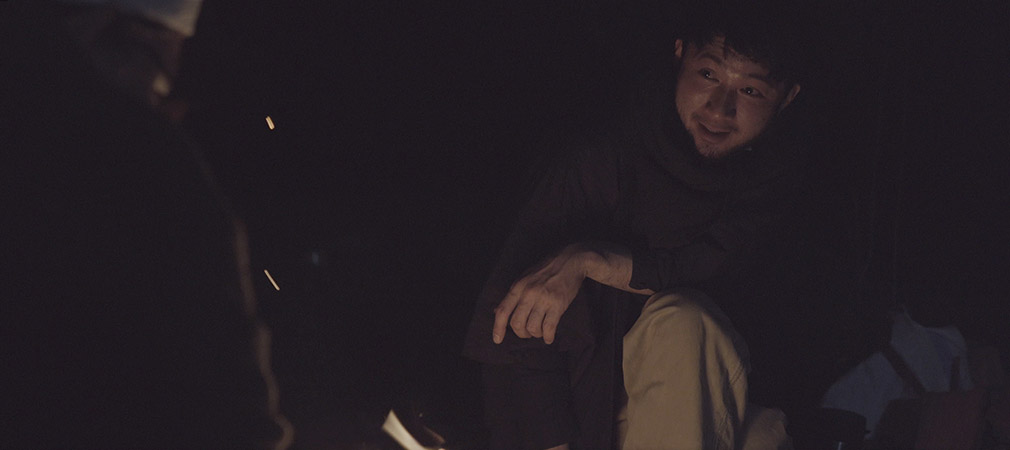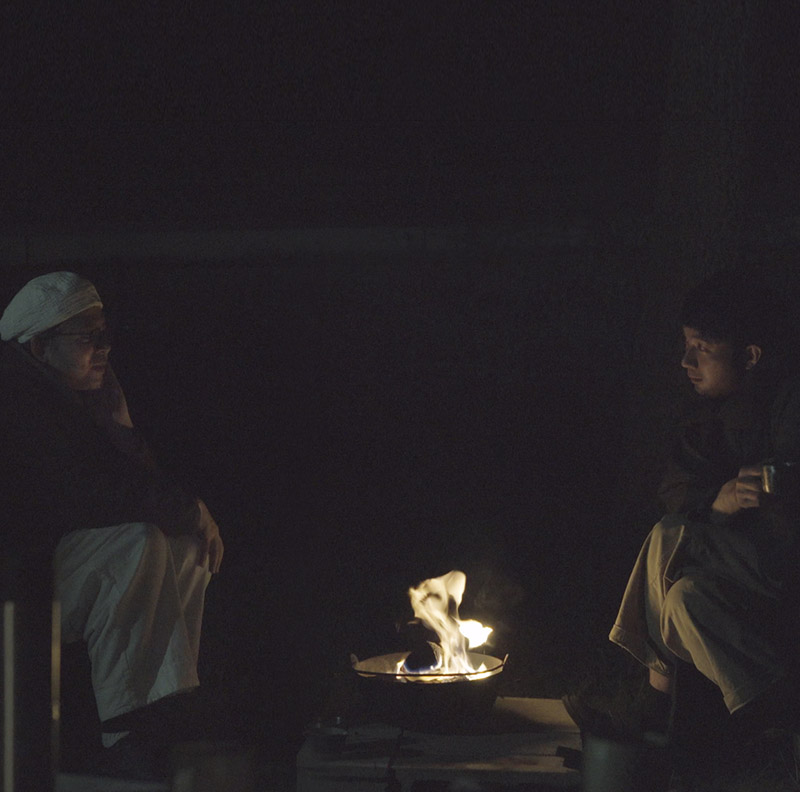

- Akiyoshi: It was our first time meeting. I wonder what I thought at that time. Mr. Urakami was from a world that I was not a
part of, but he came into my life and that smoothly led to us collaborating. What were the thoughts that led up to that?
- Urakami:Well, I was happy. I am the kind of person that will look left when everybody else is looking right. I place a lot of
importance on the venues for my exhibitions and the places where my work will be shown. To put in extremes, I want
to do what others aren’t doing. I want to try new things. There was constantly a place for me to do that, and I was
truly happy about that.

- A: It wasn’t like I was making a living off of the act of managing galleries. I’ve done fashion-related work for over 20
years, so it was only natural for me to have a desire to interact with people who create. As far as I know, and out of all
of the artists I’ve seen make works through the use of wood, Mr. Urakami’s creations are the ones that I’ve found
interesting since first seeing them. They gave off a different scent than other work. They gave me my own unique
thoughts. They made me think “perhaps if it was done this way, then it would be a little more interesting”. But more
than anything, they made me want to meet him. First, I just wanted to see what kind of job he was doing. So there
were hardly any mentions of “offers” or anything of the like; we simply met and talked. Our first time interacting with
each other was pretty much just that, but through that I was sure that he was probably able to understand the things I
wanted to say as well as the things that I wanted to do. When we talked for a second time, things were already going
smoothly, and there was a moment when it was decided that we would create something through the new project that
I had in mind. From there, it led to us discussing a title for the project. Isn’t that how it went?
- U: That is correct.
-
A: More so than sharing concepts with each other, we wanted to share a single word and start thinking based on that
word. Mr. Urakami himself wanted that word, and there was also a moment where I felt that I wanted to decide on the
title right then and there. We talked amongst ourselves for around an hour, right?
- U: Yes, we did.
- A: I wanted to do something that showcased a type of work by Mr. Urakami that has never been seen before, plus the
cynical part of me constantly wanted a strong creation that was “more than something that is widely accepted by the
masses, but something that is enthusiastically supported by a select few people”. I thought it would be a good
opportunity to show an essential part of a creator’s craft. When I was thinking about that, I wanted the creator to
make something that wouldn’t be accepted by everybody, but had a select few sympathizers. In other words, I wanted
something that would pierce through the ones who shared that common feeling. I told Mr. Urakami how I wanted to
provide that piercing sensation. That’s when I came up with the title “use-less”. Directly translated, it means “of no
use”. However, by my meaning it is: “something that cannot be easily used by anybody, but something that is useful
to a select few people”. In other words, for the people who find it useful, they will discover its value when they bring it
into the space that their life encompasses. I wanted to provide a creation that breaks through to those few people,
which is the concept behind our title. As soon as we were able to share that single word, we were able to get a
concrete image of the works we wanted for this exhibition.
- U: Yes we were. Plus this concept is considerably close to the kind of work we were already consciously making, so it
all went smoothly.
- A: As a creator, was it just something that I’ve never been able to do up until now? Or perhaps the timing was just
never right. I’ve probably had this idea in my head before.
When we came up with use-less, how did you feel about it?
- U: First I felt as if you paraphrased my thoughts into words. For me, I feel that a tool can’t be something that is only
easy to use. The tool itself has to have an idiosyncrasy. Understanding that concept, the user of that tool searches for
that idiosyncrasy and discovers their own easiest way to use it. That’s the feeling I get. I myself am not an artist, so I
have always had that feeling whenever tools came to mind. But for the longest time, I could not put that feeling into
words. When Mr. Akiyoshi came up with “use-less”, I thought “this is it”.
- A: As a single word, it is a bit extreme though.
- U: I was quite happy about getting this theme. There was nothing to be ambivalent about. I could come into contact
with it as it is. Well maybe “as is” isn’t quite right. I felt that Mr. Akiyoshi might have delivered something that I was not
able to come into contact with until that point. Yes, this was an enjoyable theme.
- A: In other words it's “idiosyncrasy“, right? Something with an idiosyncrasy can be loved obsessively. If that
idiosyncrasy is firmly conveyed, the work can become something that is incredibly interesting to somebody out there.
For example, wanting the creator to produce something that is odd. In the world of clothing, that would be phrased as
something that is a bit twisted or cynical, but what I am talking about does not take on the meaning of a sarcastic
curveball or anything like that.
- U: I get what you’re saying.
- A: A creation that is straightforward but has its own idiosyncrasy. That might be difficult to understand, and it might
not be understood by everybody. In any case, it is something with a positive meaning.
- U: In the end, those are the kind of works that remain in people’s memory. That is what I’m aiming for. To bring that
into fruition, it not only takes me providing various works, but the user— the person who chooses the works— has to
do some thinking as well. It probably sounds like I am looking down on the users, but I actually intend to be on an
even field with them.
- A: To leave room for the user to decide how they make use of the item, how they view the item, makes the creator
feel blessed to be in their position. Of course, providing something that has an already-defined use also gives that
feeling.
- U: That is also true, without a doubt.
-
A: That concept itself is not wrong. But proposing that the user is free to decide how they will use the item— though it
comes with some fear— births communication between the creator and the user. There is a message there. Will the
person receiving it be able to catch its meaning? Making that communication possible is probably what works with
idiosyncrasies are all about.
- U: When first hearing the word useless, there was a hurdle that I had to overcome within myself. I had to figure out
how to interpret it. There are various— countless— ways to interpret it. You can probe from various angles. I of
course make various works, for example I could add religious symbols or motifs on it. I mean it’s just a box, but I try to
make part of it suggestive. That’s also one of the ways to express use-less, right? I have never seen that kind of
approach before, and because it came to me naturally, I thought that it might work.

- A: Adding motifs to items is quite the challenge.
-
U: Indeed. The flow of our project did not include adding motifs.
- A: Whether we call that a motif or something else, taking an approach where one devises an introduction is a
challenge for the creator, because you are giving it meaning ahead of time.
- U: Yes, it’s quite the challenge. But I want to give it a shot. For the technical approach to decorate an object, for
example, we can apply it 3-dimensionally. Applying it to the surface is already one method, but we can also apply it to
a single 3-dimensional object. I feel that might be a new approach.
- A: By the way, when you make things, do you start from design? Or do you begin by deciding how you will shave
down the material? Is there some kind of theory that you apply to your process?
- U: I do both, of course. I do both, but if I had to lean one way or the other, I’d say that I start with the material. Even if
we say that, we are creating from timber and materials that have already been sawed down, so aspects like the
thickness and the grain are already decided. So creating something also requires the ability to design. However, it’s
not like we’re just stocking up on materials and going about making things for the future. In that sense, everything is
based on the material
- A: There are times where the material is developed and designs are not included at all, and there are also
approaches where the motif and design are integrated into the process. When using lacquer or gilt, do you usually
think of that at the end, like something you decide to add on?
- U: I guess feeling comes into play. Yes, there’s also that.
- A: Do you put that into your work as well?
- U: Yes, because I want it to last, after all. When working with lacquer, from a historical angle, the lacquer easily lasts.
In other words, there is of course the idea that the lacquer will endure through long periods of use, but more than that,
there is the memory aspect. I feel that people might place the most value on that aspect. Receiving something means
that it will remain in your memory, or it won’t. I feel that life itself works in that way as well. Whether one has money or
not, it is about whether or not the memory of something is deep. In the final analysis, isn’t that how it is?









